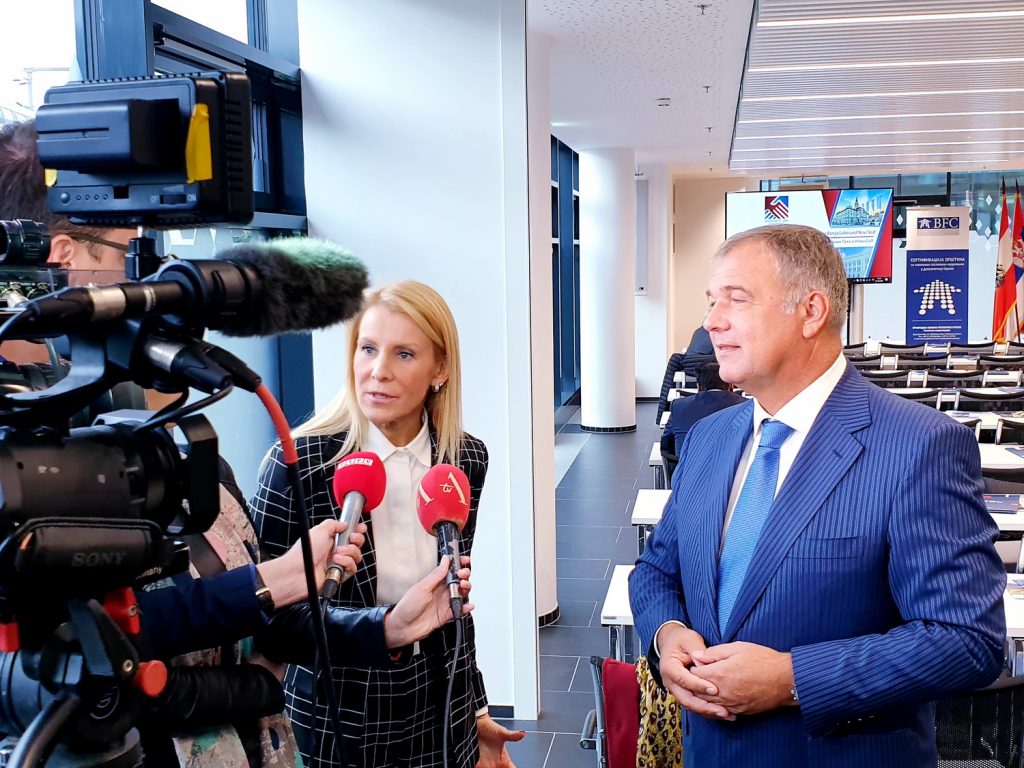The number of companies that decide to enter the Austrian market from Serbia, which is often seen as a springboard for the entire German-speaking area, is growing. I think that we are stronger together, so I always suggest to company directors from Austria to talk to each other and connect
Exports from Serbia to Austria in 2021 went up by 24.6% compared to 2020, i.e. from 565.729 million euros to 704.982 million euros. When it comes to Austrian exports, they recorded a 24.1% growth in 2021, i.e. from 686.54 million euros to 851.96 million euros. Austrian companies mostly exported cars and other vehicles (292.15 million euros), processed goods (200.03 million) and chemical products (166.75 million euros) to Serbia. The value of total trade between the two countries in 2021 was 1.557 billion euros, which is a significant increase compared to 2020 when it amounted to 1.252 billion euros.

The trade between Austria and Serbia has been constantly growing. In which sectors can this trade be even better and what sectors have recorded a declining trade?
Serbia mostly exported the following products to Austria – processed goods, cars and other vehicle categories, food products and live cattle, as well as various finished products. In these four commodity groups, Serbia exported goods worth 179.5, 168.7, 127.93 and 123.64 million euros, respectively. The growth of Serbian exports was recorded in the categories such as food products and livestock (+60.2%), processed goods (+ 30.4%) and cars and other categories of vehicles (+28.8%). The largest decline in exports was recorded in mineral fuels and lubricants (-52.7%) and raw materials (food products and mineral fuels were excluded from this category), with a decline of 42.9%. These are also the only product groups that Serbian exports that recorded a decline. All other export groups recorded growth.
“Regardless of these negative developments, trade with Serbia is expected to grow”
Bearing in mind the global business opportunities, which are primarily related to disturbances in supply chains, especially the supply from distant destinations, where transport is frequently interrupted and costs have been constantly growing, we can expect that Serbian exports will continue to grow, primarily the export of food, finished goods and machine parts and components.
What are Austrian investors most interested in Serbia? Do we operate with Austria in the IT sector?
As the predominant forms of cooperation, I would mention that Serbian companies work as suppliers of various IT services and software and project solutions, while recently quite a few well-known Austrian corporations have acquired a number of small but successful Serbian IT companies. Given that Austrian companies in this sector are aware that the Serbian potential in terms of IT experts, although quite strong at the moment, has its limitations, they are trying to find modalities to allow experts to move and work more easily between the two countries.
Austrian companies want the Austrian legislation to change to enable Serbian experts to move circularly through both countries, while enjoying the benefits of life in Serbia where they come from, but also have high salaries that Austrian companies can offer. I also have to mention that the growth of personal income in this sector in Serbia is quite significant, that Austrian companies are aware that they have to allocate substantial financial resources to pay for a top expert or a top product, and that they are ready to do that.

What should we do more to improve Serbian exports to Austria?
It is important that Serbian companies, which already have successfully exported to the countries in the neighbourhood, realize that each market has its own peculiarities. These companies already have experience with entering a new market, so you have to be acquainted with the laws regulating business in the country, for the company to have associates who speak German (if we are talking about Austria) and to know who are your potential partners that you need to communicate with.
“The number of Serbian tourists visiting Austria is on the rise, so although we cannot say that these are drastic jumps, there is an improvement for now”
Companies with good products are usually the ones that decide to make such a step forward, but they also have to be aware of other financial expenses related to it. If the parameters of the product match, then persistence is crucial because you will certainly not sell the product by making a phone call or two or sending an e-mail offering something. You have to arm yourself with patience because you have to gain the trust of a business partner who must overcome the prejudices that might exist and you must certainly be willing accept rejection, i.e. take a “no” for an answer because that can be demoralizing.
How will the current situation and the ban on maize export affect the trade between Serbia and Austria, given that maize is the third biggest product that Serbia exports to Austria?
In the coming weeks and months, a regular supply of maize will not only be a topic in Austria but will also be a problem in the European Union. We should bear in mind that almost Ukraine exports 52% of maize consumed in the EU.
In addition to the Ukrainian crisis, export restrictions imposed by Hungary, which is the main maize supplier to Austria, have caused sharp price increases. We should add to this the decision made by the Serbian government to ban the export of maize. It is quite certain that prices will continue to rise as demand grows and deliveries are limited. This trend will be difficult to halt if the conflict in Ukraine continues to disrupt deliveries.
It all depends on which measures will the Serbian government implement regarding export, but there will certainly be opportunities to generate additional income if supplies are formed promptly. It would also make sense to think about increasing our primary production. There is also a possibility of increasing the Serbian export of processed animal feed produced from mixtures, super concentrates and premixes because the demand for them will certainly increase. The same applies to wheat because if the EU cannot procure all the required quantities of wheat, this probably will be compensated through the export of flour, pasta and other flour-based products.
Should we expect an increase or decrease in consumption in Austria and how would that affect economic cooperation with Serbia?
According to all indicators from the first quarter of this year, the Austrian economy will grow strongly, primarily due to the steps taken regarding the opening of the economy after the country imposed numerous restrictions on population movement to prevent the spread of coronavirus. According to estimates by the Wifo Institute for Economic Research, these indicators are expected to fall sharply in the second and third quarters, i.e. economic growth is expected to be very low compared to the first quarter due to EU sanctions against the Russian Federation and reciprocal countermeasures.
The National Bank of Austria has warned that if the fighting in Ukraine lasts for a longer period, there will be a further decline in gross national income, as well as a further rise in inflation. Inflation in this case could reach a new record of 9%. The prices of motor fuel went up the most, which is currently 30% more expensive compared to the same period last year, the price of gas is 65% more expensive, while heating oil recorded a price increase of 45%. The prices of food and non-alcoholic beverages rose by an average of 4.3%, while bread and other cereal products went up by 6%. Cooking oils and other dietary fats recorded a 13% increase, juices 9.6%, while coffee costs 6% on average.
Regardless of these negative developments, trade with Serbia is expected to grow. The ties between our two countries economic have been stronger in recent years and our companies have stepped up their networking activities. Because of other disturbances, which I have already mentioned, and which relate to disrupted supply chains, regional cooperation and trade should intensify.

Can the two countries focus more on tourism too?
The number of Serbian tourists visiting Austria is on the rise, so although we cannot say that these are drastic jumps, there is an improvement for now. The biggest growth is recorded in the city break segment because Belgrade has a reputation of being a metropolis that does not sleep and has an exciting nightlife, which appeals to younger Austrians who are becoming increasingly interested in coming to Belgrade. In regard to slightly older generations, there is a growing interest in hunting tourism as well as wine-related routes. Austria, like Serbia, is a continental country, and yet it is one of the world’s most famous tourist destinations when it comes to city, congress, spa and winter tourism. The level of service in Serbia has drastically improved, and if something good came out of the corona-induced crisis, it’s the fact that people in Serbia spent much more time in their own country and explored Serbian tourist destinations that are truly exceptional and have a lot to offer. In terms of the Austrian market, Serbia needs to invest much more in advertising campaigns and cooperation with travel agencies that will offer travel arrangements, because they are crucial when it comes to a direct offer to the customers. So, this area has potential, but since we offer those travel arrangements for which Austrians occupy a notable place, we have to engage in and work more on that.
Is the Austrian labour market still looking for a foreign workforce? How did the coronavirus measures affect the Austrian labour market?
The labour market has fully recovered from the extraordinary circumstances of the previous period. Although a number of refugees from Ukraine came to Austria (probably over 20,000 of them currently), who are given the right of residence and access to the labour market, their number probably won’t significantly reduce the need for foreign workers, primarily in those industries that require a worker to have a nostrified school diploma. At the federal level, the Austrian Ministry of Labour has compiled a list of 66 deficient occupations for 2022. There are also lists at the provincial level that has additional professions on them and for which there is a strong need regionally. The demand for experts who have a university education is strong in Austria, as is the demand for numerous jobs that require completed vocational or high school education. Every person who is interested in working in Austria should know that, in addition to finding a company that is interested in hiring them, this company also has to be willing to pay them more than the salary stated in collective job agreements for each economic sector in Austria.